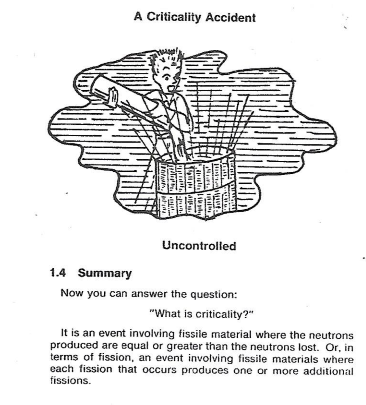
CWP Blog | CWP
Nuclear Criticalities at DOE Facilities
November 15, 2019
November 15, 2019
CWP
CWP Blog
Talk to Terrie:
Nuclear Criticalities at DOE Facilities
Shortly after I married my husband 31 years ago, he came home from his job at Rocky Flats with a small handbook for me to read. It was titled Nuclear Criticality Safety Review Handbook. He had permission to bring this home.
My original purpose of writing this blog was to try to explain in layman’s terms what a criticality accident is. This occurrence is also described as an “excursion” or “unplanned event.” An unplanned criticality will most likely cause the death of an unprotected individual.
It was not unusual to have planned criticality experiments performed in Department of Energy (DOE) labs. Some of these experiments were conducted to determine the safest way to store radioactive materials.
Rocky Flats Critical Mass Lab for instance performed over 1700 experiments. I located a report from the year 2000 published by the Los Alamos National Laboratory (LANL) which summarizes criticality accidents at DOE nuclear weapons facilities and around the world. The 2000 report shows that the Oak Ridge National Laboratory (ORNL), also known as X-10, conducted planned criticality experiments. There were four incidents at ORNL through 1968.
And then, as my friend is wont to say, I fell down the rabbit hole.
I am familiar with some of the criticalities that occurred in the early years of nuclear weapons production and I wanted to check the 2000 report to see if there were some I didn’t know about. Unfortunately, there were.
I saw a listing for a criticality accident on page 33 of the 2000 report which took place at the United Nuclear Fuels Recovery Plant located in Wood River Junction, RI on July 24, 1964. New England Today published an article which describes the horrifying accident and what occurs during a criticality accident much clearer than I could.
This discovery led me to take a look at the facilities covered by the Energy Employees Occupational Illness Compensation Program Act (EEOICPA). This facility is not listed as a covered facility although the site apparently had a contract under the Atomic Energy Commission to reclaim uranium from fuel rods and scrap metal. More research will be needed to determine whether United Nuclear Fuels Recovery plant in Rhode Island should be a covered DOE facility.
The good news is that DOE and its predecessor agencies took the necessary steps to prevent fatalities from a criticality. According to the 2000 report, there has not been a confirmed criticality at a DOE nuclear weapons facility since 1978.

